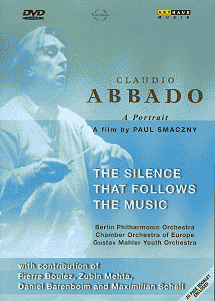This documentary film of the conductor Claudio Abbado
is a fascinating document of a well travelled famous conductor at work
and play. It was filmed before his well documented serious illness and
is an illuminating study into what makes him tick.
The film features three notable European ensembles,
the Berlin Philharmonic of which at the time he was principal conductor,
and with two other ensembles that he founded some years ago and with
which he still has very close links the Chamber Orchestra of Europe
and the Gustav Mahler Youth Orchestra.
The film is a mixture of music excerpts and interviews
with the conductor himself, and colleagues in each of the ensembles
and with friends in the music industry, principally Daniel Barenboim,
Pierre Boulez, Zubin Mehta and Maximillian Schell.
The Berlin Philharmonic is shown rehearsing sections
of Elektra (with Deborah Polaski, Karita Mattila, Marjana Lipovsek and
Ferrucio Furlanto) and Beethoven’s Pastoral Symphony. One is able to
see how he works with artists rather than in a dictatorial manner to
achieve the results he is seeking. Given an ensemble which is renowned
for its musical abilities and standards, the results of a period of
rehearsal are remarkable. There have been some well publicised conflicts
between Abbado and the orchestra, some of which he refers to in the
documentary, but these seem to be well behind them now. I firmly believe
that the orchestra, and the music-loving public will miss him immensely
when he moves on to other things.
The Chamber Orchestra of Europe is shown rehearsing
and performing excerpts from Il Barbiere di Siviglia Overture,
Schubert’s Symphony No. 2 and Arnold Schoenberg’s Kammersinfonie No.
1. Throughout these performances, one can sense the close rapport between
the conductor and ensemble and the respect the players have for him
in their work together. Particularly with the Schubert, which Abbado
has recorded very successfully with this ensemble. the corporate ‘togetherness’
is outstanding and to see the end of the work in finished performance
is heart-warming. In the documentary part of this programme, Abbado
is asked "how do you achieve the results you require?" The
answer is unequivocal – "I work with the orchestra and accept gladly
any suggestions they may have to make the performance better, since
their interpretative ideas are just as good as mine, why shouldn’t I
take notice?" This attitude seems to work wonders with his orchestras,
and it becomes clear that the Berlin Philharmonic found this both refreshing
and extremely frustrating after many years under Herbert von Karajan,
who, as we know, had very clear ideas exactly how a piece should go
and go it would.
Even so, when he believes he is right, he can be firm
to the point of obsession. The excerpts with the Gustav Mahler Youth
Orchestra also show this feature very clearly in the rehearsal with
Maria João Pires. A passage in the Beethoven 3rd Piano
Concerto is under rehearsal where pianist wants one thing, and conductor
the other. Discussions, try-outs and finally Pires has to agree that
Abbado’s way is better – a fascinating study of man management. The
last excerpt is of Bruckner’s 9th Symphony and the Gustav
Mahler Orchestra give of their all for their Music Director.
A wonderful DVD and well worth watching – highly recommended.
John Phillips
